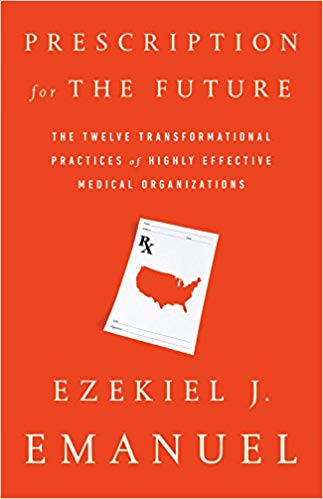Ezekiel Emanuel
Public Affairs
New York, NY
2017
255 pages
According to the Art:
Emanuel builds the book around twelve transformational practices as developed and applied in the several different health care organizations he studied that could potentially deliver higher-quality and lower-cost care for Americans.
Synopsis:
The future of health care in the US has long been a subject of debate, with how to pay for it overshadowing other aspects of the topic. In writing this work, Dr. Ezekiel Emanuel, makes clear: “This book is about [the] transformation in the delivery of care in the United States” needed to ensure that “all Americans receive consistently higher-quality and lower-cost care.” (p. 15) Paying for health care is not ignored, and indeed how health care payment methods figure in health care delivery is taken into account.
Emanuel builds the book around twelve particular transformational practices as developed and applied in the several different health care organizations he studied. They included “small physician offices and large multispecialty group practices, accountable care organizations, large managed-care organizations, and even for-profit companies.” He admits to finding these organizations in “a careful, if somewhat haphazard, way” through a combination of serendipitous visits to some of these organizations, attendance at presentations showcasing some of them, and personal recommendations received. (p. 15) Emanuel identifies these twelve transformational practices through “carefully observing and ascribing significance when various groups and organizations in many different geographic locations, are independently reporting similar things.” (p. 16)
The twelve transformational practices are covered across three chapters in the middle of the book. The first describes the practices that involve the way physician offices are structured and operate (e.g., scheduling patients, measuring physician performance, standardizing care, coordinating care), the second describes the practices that affect provider interactions with patients (e.g., shared decision making, site of service considerations), and the third, the practices that expand the scope of care beyond traditional boundaries (e.g., behavioral health, palliative care). Emanuel provides considerable detail on what these transformational practices entail and on the results they produce. These chapters are preceded by a separate chapter on recent changes in health care stimulating transformations, and a chapter on essential elements required for transformation: catalyzing crisis; leadership; culture, governance, and physician engagement; data; physician management alignment; and financial risk.
Emanuel recognizes that: “No organization can institute all twelve transformational practices all at once. No organization has the management capacity to do that.” (p. 197) Thus, he devotes a chapter on how organizations can adopt the transformational practices that are best suited to them. He aggregates the practices into three tiers and ranks them by prioritization. He carves out a separate chapter on “virtual medicine”—a collection of technologies and methods that enable a range of patient care activities (e.g., diagnosing, treating, monitoring) between different locations. Emanuel covers virtual medicine separately because his view is counter to the conventional wisdom espoused by “the medical techno-utopians,” as he calls them (p. 166) He allows that it can augment health care organization performance but itself is not a transformational practice because “healthcare is fundamentally social.” (p. 175) So as not to leave patients wondering how they could benefit from these practices, he devotes another chapter for them on how to find a doctor.
Analysis:
Dr. Emanuel is a medical oncologist, bioethicist, and health policy expert. He has been thinking and writing about health policy issues for decades, and was one of the “architects” of the Affordable Care Act (aka, “Obamacare”).
Emanuel was out in the field for this book (as he has been for his other books), and the twelve transformational practices he describes were developed from the bottom up within the organizations he studied. Thus, besides gleaning these practices from his observations, he highlights how individual health care provider organizations can take initiatives on their own to improve performance, and that they did not have to be organizations of a particular stature, reputation, or grandeur.
Also, as Emanuel dug deep into the workings of these organizations to unearth the key components of transformational practices, he found an important factor common to most of them that would not surprise anyone if this book had been published in the mid 1900s, but could surprise many as it’s published in 2017:
Offices and health systems that have made chronic care management work do not necessarily deploy lots of technology, such as continuous glucose monitors, continuous heart monitors, high-technology pill dispensers, and remote cameras monitoring. They instead rely on human-to-human contact—and lots of it—from everyone on the healthcare team. Successful places, in short are characterized by low-tech but high-touch care.
p. 98
This book, then, also reanimates a principle articulated back in 1925 by Dr. Francis Peabody: “For the secret of the care of the patient is in caring for the patient.” The timing couldn’t have been better to put focus on patient care when health care payment debates attract all the attention otherwise.
Also:
A way to account for payment issues in relation to Emanuel’s transformational practices is to read Elisabeth Rosenthal’s book, An American Sickness: How Healthcare Became Big Business and How You Can Take it Back, which was released about the same time as Emanuel’s book and is reviewed here.
A version of this review is posted at the NYU Literature, Arts and Medicine Database.



